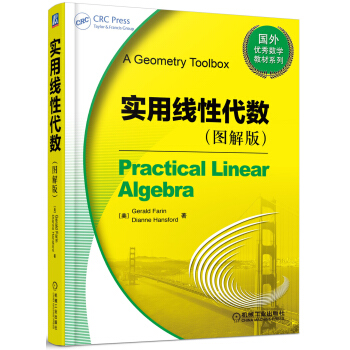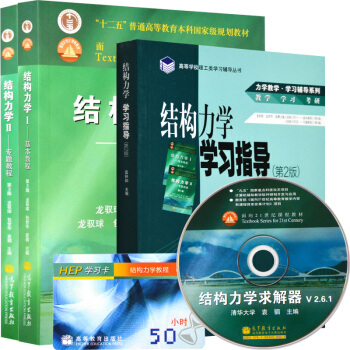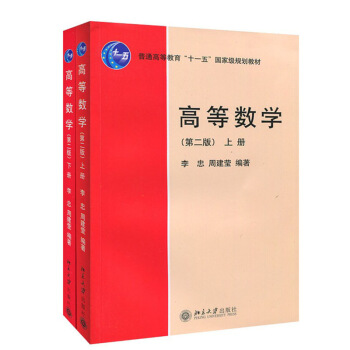

具体描述
编辑推荐
适读人群 :大学生、大学教师 《实用线性代数(图解版)》为英文原文中文注释版本,由一线教学任课老师在书中难点部分作出注释讲解。从几何直观的视角来审视线性代数的内容。
内容简介
本书区别于以往线性代数的书籍,内容新颖,编排独特,作者以几何视角讲述线性代数,通过二维平面和三维空间中的例子解释线性代数中的各种概念和性质。本书强调直观性以及知识点的背景,结合计算机中各种图形的变换来理解线性变换,注重可读性的同时突出数学的基本思想,将直观图形与数学证明进行了巧妙的结合。作者在书籍侧边空白处手绘200余幅示意图给出了相关概念的解释,更好的帮助读者理解。本书可供非数学类专业的学生及数学爱好者使用,亦可作为数学专业学生和教师的参考用书。作者简介
杰拉德·法林(Gerald Farin),1979年于布伦瑞克大学获博士学位,著有"Curves and Surfaces for CAGD" (5th ed.), "NURBS" (2nd ed.)。同时他还兼任《计算机图形设计》主编。
内页插图
精彩书评
★“这是一本鼓舞人心的书,书中涵盖了线性代数的所有内容,其中包含很多耐人寻味的例子,对于纯数学家了解更多关于线性代数的应用也很有意义”
——American Mathematical Society(AMS)
目录
笛卡儿的发现 1 第1章1.1 二维平面中局部坐标与整体坐标的互化 2
1.2 整体坐标到局部坐标的转化 6
1.3 三维空间中局部坐标与整体坐标的互化 8
1.4 单位框外一点坐标的转化 9
1.5 建立坐标系 10
1.6 习题 12
无处不在:二维平面中的点与向量 13 第2章
2.1 点与向量的坐标及运算 14
2.2 点与向量的区别 16
2.3 向量场 17
2.4 向量的长度 18
2.5 点的组合 21
2.6 线性无关 24
2.7 标量积 24
2.8 正交投影 28
2.9 不等式 29
2.10 习题 30
排列起来:二维平面上的直线 33 第3章
3.1 直线的定义 34
3.2 直线的参数方程 35
3.3 直线的隐式方程 37
3.4 直线的显式方程 40
3.5 参数方程与隐式方程的互化 41
3.6 点到直线的距离 43
3.7 点在直线上的投影 47
3.8 相遇的地方:直线相交的计算 48
3.9 习题 54
改变形状:二维平面上的线性映射 57 第4章
4.1 倾斜的目标框 58
4.2 矩阵形式 59
4.3 矩阵的计算性质 61
4.4 图形放缩 63
4.5 图形反射 65
4.6 图形旋转 68
4.7 图形切变 69
4.8 图形投影 71
4.9 投影的核 73
4.10 面积与线性映射:行列式 74
4.11 线性映射的复合 77
4.12 矩阵乘法的更多性质 81
4.13 矩阵运算的更多性质 83
4.14 习题 84
2×2线性方程组 87 第5章
5.1 再议倾斜的目标框 88
5.2 矩阵形式 89
5.3 直接求解法:克拉默法则 90
5.4 高斯消元法 91
5.5 取消映射:逆矩阵 93
5.6 无解方程组 99
5.7 欠定方程组 100
5.8 齐次方程组 100
5.9 数值应用:主元法 102
5.10 用矩阵定义映射 104
5.11 习题 104
在周围移动:二维平面上的仿射映射 107 第6章
6.1 坐标变换 108
6.2 仿射映射与线性映射 110
6.3 平移 111
6.4 更多常见的仿射映射 112
6.5 从三角形映射到三角形 114
6.6 仿射映射的复合 116
6.7 习题 120
特征 123 第7章
7.1 固定方向 124
7.2 特征值 125
7.3 特征向量 127
7.4 特殊情形 129
7.5 对称矩阵的几何图形 132
7.6 重复映射 135
7.7 映射的条件数 137
7.8 习题 138
剖分:三角 141 第8章
8.1 重心坐标 142
8.2 仿射不变性 144
8.3 几个特殊点 145
8.4 二维平面上的三角剖分 148
8.5 数据结构 149
8.6 点的位置 150
8.7 三维空间中的三角剖分 151
8.8 习题 153
圆锥曲线 155 第9章
9.1 常见的圆锥曲线 156
9.2 圆锥曲线类型的判定 160
9.3 圆锥曲线位置的判定 162
9.4 习题 163
三维空间中的几何 165 第10章
10.1 从二维到三维 166
10.2 向量积 168
10.3 直线 172
10.4 平面 173
10.5 应用:光与影 177
10.6 标量三重积 180
10.7 线性空间 181
10.8 习题 183
三维空间中的相交 185 第11章
11.1 点与平面的距离 186
11.2 两直线间的距离 187
11.3 直线与平面相交 189
11.4 直线与三角形相交 191
11.5 光在平面上的反射 191
11.6 三个平面相交 193
11.7 两个平面相交 194
11.8 建立正交坐标系 195
11.9 习题 197
三维空间中的线性映射 199 第12章
12.1 矩阵与线性映射 200
12.2 图形放缩 202
12.3 图形反射 204
12.4 图形切变 204
12.5 图形投影 207
12.6 图形旋转 209
12.7 体积与线性映射:行列式 213
12.8 线性映射的组合 216
12.9 更多的矩阵性质 218
12.10 逆矩阵 219
12.11 习题 221
三维空间中的仿射映射 223 第13章
13.1 仿射映射 224
13.2 平移 225
13.3 四面体的映射 225
13.4 投影 229
13.5 齐次坐标与透视映射 232
13.6 习题 238
一般线性方程组 241 第14章
14.1 问题的引入 242
14.2 高斯消元求解法 244
14.3 行列式 250
14.4 超定方程组 253
14.5 逆矩阵 256
14.6 矩阵的LU分解 258
14.7 习题 262
一般线性空间 265 第15章
15.1 基本性质 266
15.2 线性映射 268
15.3 内积 271
15.4 格拉姆-施密特正交化方法 271
15.5 高维特征问题 272
15.6 空间一览 274
15.7 习题 276
数值方法 279 第16章
16.1 线性方程组的另一种解法:豪斯霍尔德法 280
16.2 向量的范数与序列 285
16.3 方程组的迭代解法:高斯-雅可比法与高斯-赛德尔法 287
16.4 求特征值:幂法 290
16.5 习题 294
直线组团来袭:折线和多边形 297 第17章
17.1 折线 298
17.2 多边形 299
17.3 凸性 300
17.4 多边形的类别 301
17.5 不常见的多边形 302
17.6 转向角与分支数 304
17.7 面积 305
17.8 验证共面问题 309
17.9 验证点与多边形的位置问题 310
17.10 习题 313
曲线 315 第18章
18.1 应用:参数曲线 316
18.2 贝齐尔曲线的性质 321
18.3 矩阵形式 323
18.4 导数 324
18.5 合成曲线 326
18.6 平面曲线的几何 327
18.7 沿曲线移动 329
18.8 习题 331
后记教程 333 附录A
A.1 来个例子热身一下 333
A.2 复习 336
A.3 仿射映射 338
A.4 变量 339
A.5 环 340
A.6 CTM 341
部分解答 343 附录 B
词汇表 367
参考文献 371
索引 373
Contents
Preface
Descartes’ Discovery 1 Chapter 1
1.1 Local and Global Coordinates: 2D 2
1.2 Going from Global to Local 6
1.3 Local and Global Coordinates: 3D 8
1.4 Stepping Outside the Box 9
1.5 Creating Coordinates 10
1.6 Exercises 12
Here and There: Points and Vectors in 2D 13 Chapter 2
2.1 Points and Vectors 14
2.2 What’s the Difference 16
2.3 Vector Fields 17
2.4 Length of a Vector 18
2.5 Combining Points 21
2.6 Independence 24
2.7 Dot Product 24
2.8 Orthogonal Projections 28
2.9 Inequalities 29
2.10 Exercises 30
Lining Up: 2D Lines 33 Chapter 3
3.1 Defining a Line 34
3.2 Parametric Equation of a Line 35
3.3 Implicit Equation of a Line 37
3.4 Explicit Equation of a Line 40
3.5 Converting Between Parametric and Implicit Equations 41
3.6 Distance of a Point to a Line 43
3.7 The Foot of a Point 47
3.8 A Meeting Place: Computing Intersections 48
3.9 Exercises 54
Changing Shapes: Linear Maps in 2D 57 Chapter 4
4.1 Skew Target Boxes 58
4.2 The Matrix Form 59
4.3 More about Matrices 61
4.4 Scalings 63
4.5 Reflections 65
4.6 Rotations 68
4.7 Shears 69
4.8 Projections 71
4.9 The Kernel of a Projection 73
4.10 Areas and Linear Maps: Determinants 74
4.11 Composing Linear Maps 77
4.12 More on Matrix Multiplication 81
4.13 Working with Matrices 83
4.14 Exercises 84
2×2 Linear Systems 87 Chapter 5
5.1 Skew Target Boxes Revisited 88
5.2 The Matrix Form 89
5.3 A Direct Approach: Cramer’s Rule 90
5.4 Gauss Elimination 91
5.5 Undoing Maps: Inverse Matrices 93
5.6 Unsolvable Systems 99
5.7 Underdetermined Systems 100
5.8 Homogeneous Systems 100
5.9 Numerical Strategies: Pivoting 102
5.10 Defining a Map 103
5.11 Exercises 104
Moving Things Around: Affine Maps in 2D 107 Chapter 6
6.1 Coordinate Transformations 108
6.2 Affine and Linear Maps 110
6.3 Translations 111
6.4 More General Affine Maps 112
6.5 Mapping Triangles to Triangles 114
6.6 Composing Affine Maps 116
6.7 Exercises 120
Eigen Things 123 Chapter 7
7.1 Fixed Directions 124
7.2 Eigenvalues 125
7.3 Eigenvectors 127
7.4 Special Cases 129
7.5 The Geometry of Symmetric Matrices 132
7.6 Repeating Maps 135
7.7 The Condition of a Map 137
7.8 Exercises 138
Breaking It Up: Triangles 141 Chapter 8
8.1 Barycentric Coordinates 142
8.2 Affine Invariance 144
8.3 Some Special Points 145
8.4 2D Triangulations 148
8.5 A Data Structure 149
8.6 Point Location 150
8.7 3D Triangulations 151
8.8 Exercises 153
Conics 155 Chapter 9
9.1 The General Conic 156
9.2 Analyzing Conics 160
9.3 The Position of a Conic 162
9.4 Exercises 163
3D Geometry 165 Chapter 10
10.1 From 2D to 3D 166
10.2 Cross Product 168
10.3 Lines 172
10.4 Planes 173
10.5 Application: Lighting and Shading 177
10.6 Scalar Triple Product 180
10.7 Linear Spaces 181
10.8 Exercises 183
Interactions in 3D 185 Chapter 11
11.1 Distance Between a Point and a Plane 186
11.2 Distance Between Two Lines 187
11.3 Lines and Planes: Intersections 189
11.4 Intersecting a Triangle and a Line 191
11.5 Lines and Planes: Reflections 191
11.6 Intersecting Three Planes 193
11.7 Intersecting Two Planes 194
11.8 Creating Orthonormal Coordinate Systems 195
11.9 Exercises 197
Linear Maps in 3D 199 Chapter 12
12.1 Matrices and Linear Maps 200
12.2 Scalings 202
12.3 Reflections 204
12.4 Shears 204
12.5 Projections 207
12.6 Rotations 209
12.7 Volumes and Linear Maps: Determinants 213
12.8 Combining Linear Maps 216
12.9 More on Matrices 218
12.10 Inverse Matrices 219
12.11 Exercises 221
Affine Maps in 3D 223 Chapter 13
13.1 Affine Maps 224
13.2 Translations 225
13.3 Mapping Tetrahedra 225
13.4 Projections 229
13.5 Homogeneous Coordinates and Perspective Maps 232
13.6 Exercises 238
General Linear Systems 241 Chapter 14
14.1 The Problem 242
14.2 The Solution via Gauss Elimination 244
14.3 Determinants 250
14.4 Overdetermined Systems 253
14.5 Inverse Matrices 256
14.6 LU Decomposition 258
14.7 Exercises 262
General Linear Spaces 265 Chapter 15
15.1 Basic Properties 266
15.2 Linear Maps 268
15.3 Inner Products 271
15.4 Gram-Schmidt Orthonormalization 271
15.5 Higher Dimensional Eigen Things 272
15.6 A Gallery of Spaces 274
15.7 Exercises 276
Numerical Methods 279 Chapter 16
16.1 Another Linear System Solver: The Householder Method 280
16.2 Vector Norms and Sequences 285
16.3 Iterative System Solvers: Gauss-Jacobi and Gauss-Seidel 287
16.4 Finding Eigenvalues: the Power Method 290
16.5 Exercises 294
Putting Lines Together: Polylines and Polygons 297 Chapter 17
17.1 Polylines 298
17.2 Polygons 299
17.3 Convexity 300
17.4 Types of Polygons 301
17.5 Unusual Polygons 302
17.6 Turning Angles and Winding Numbers 304
17.7 Area 305
17.8 Planarity Test 309
17.9 Inside or Outside 310
17.10 Exercises 313
Curves 315 Chapter 18
18.1 Application: Parametric Curves 316
18.2 Properties of Bézier Curves 321
18.3 The Matrix Form 323
18.4 Derivatives 324
18.5 Composite Curves 326
18.6 The Geometry of Planar Curves 327
18.7 Moving along a Curve 329
18.8 Exercises 331
PostScript Tutorial 333 Appendix A
A.1 A Warm-Up Example 333
A.2 Overview 336
A.3 Affine Maps 338
A.4 Variables 339
A.5 Loops 340
A.6 CTM 341
Selected Problem Solutions 343 Appendix B
Glossary 367
Bibliography 371
Index 373
前言/序言
对于工科与经济类的大学生而言,“线性代数”是一门公共基础课,是必修的课程之一。常见的线性代数教科书大致有这样几个章节——行列式、线性方程组、矩阵、向量空间、特征值与特征向量、二次型。打开教材,迎面而来的就是计算与证明,鲜有知识点产生的缘由及其在实际生活中的应用。诚然,数学是一门抽象的科学,具有高度的概括性,但是这不代表数学教材就应该这样“斩头去尾烧中段”,干巴巴的毫无吸引力,冷冰冰地让人生畏。数学教育研究者们一直在呼吁数学文化的渗透,那么对于具体的一本教材而言,渗透什么内容?如何进行渗透?渗透到什么程度?我想,最基本的来说,至少要将知识的来龙去脉说个清楚。比如常见教科书开篇就是行列式的计算,那么学生肯定想要知道“行列式的本质是什么?为什么要学行列式?它在实际应用中的作用是什么?”在缺乏理解的基础上,就算学会了计算与证明,对知识的把握也是稀里糊涂的。这是件让人遗憾的事情。
本书,是一本弥补遗憾的书,是一本不同视角的书,是一本呈现知识点来龙去脉的书。本书按照先二维后三维的顺序呈现知识,使得知识形象化,便于理解。全书共分18章,第1章到第9章是二维情形,以独特的顺序与适宜的方式介绍了线性代数的基本知识点;第10章到第13章是三维情形,因此这四章是前九章的推广,但并不重复,各有仙机;第14章到第18章是高维情形,呈现了许多实际生活中的应用,同时也有助于读者抽象思维的发展。本书采用了非常规却符合认知的知识呈现顺序,以直观的、几何的叙述方式呈现内容,以大量的实际例证呈现应用。如果你不曾学过线性代数,阅读本书,会让你兴趣盎然地沉浸其中,顺理成章地掌握所有应掌握的知识点;如果你曾经学过线性代数,阅读本书,会让你不断地恍然大悟:“哦!原来这个知识点是这么来的!原来这个知识点是这么用的!原来这两个知识点竟然有这层关系!”如果你想要看一本有趣且有用的线性代数书籍,那么本书就是一个不可错过的上好选择!
alt="" />
用户评价
这本书的结构设计得非常合理,每一章的内容都衔接得很紧密,但又不会让人觉得过于拥挤。作者在每一章的开头都会设定一个“问题情境”,然后逐步引入相关的概念和方法来解决这个问题。这种“问题驱动”的学习模式,让我能够始终保持学习的动力,因为我知道我正在解决一个实际的问题。而且,每章的结尾都会有总结和练习题,这对于巩固所学知识非常有帮助。练习题的难度也循序渐进,从简单的概念理解到复杂的应用计算,让我能够逐步提升自己的能力。
评分对于我这种动手能力比较弱的人来说,能够通过视觉化的方式学习数学,简直是福音。《实用线性代数(图解版)》的图解做得非常到位,不仅仅是简单的示意图,很多图都非常有创意,能够直观地展示数学概念的运作方式。比如,在讲解行列式时,作者用图像展示了行列式如何表示一个线性变换对面积或体积的缩放比例,这让我瞬间就明白了行列式的几何意义。这种“眼见为实”的学习方法,大大降低了我的理解门槛,也让我在记忆这些概念时更加深刻。
评分作为一个已经离开校园多年的职场人士,重新拾起线性代数对我来说是一个不小的挑战。我需要学习的不仅仅是理论知识,更重要的是能够将这些知识应用到实际工作中。幸运的是,《实用线性代数(图解版)》恰恰满足了我的需求。书中列举了大量实际应用场景,从数据科学、机器学习到图像处理、信号分析,都涉及到了线性代数的知识。作者在讲解完理论部分后,会紧接着给出相应的应用案例,这让我能够清晰地看到,我学到的知识是如何解决现实问题的,极大地激发了我学习的积极性。
评分这本书的排版也非常舒服,字体大小适中,行距合理,关键是那些插图都印刷得很清晰,色彩也很饱满,一点都不会让人觉得眼花缭乱。在阅读过程中,我很少会感到疲劳,反而会因为那些精美的图画而保持愉快的心情。而且,书中对一些重要的定义和定理都用了加粗或者高亮的方式突出显示,这使得我在复习的时候,能够快速找到关键信息。这种细节上的用心,也体现了作者的专业性和对读者的尊重。
评分说实话,我当时买这本书的时候,并没有抱太大的希望,毕竟我之前的学习经历让我对这个科目已经心灰意冷。但《实用线性代数(图解版)》彻底颠覆了我的看法。作者在讲解每一个概念时,都非常注重循序渐进,从最基础的向量空间开始,一步一步地引导读者进入更复杂的领域。最让我惊喜的是,作者并没有像很多教材那样,上来就抛出一堆定义和定理,而是通过大量的实例,将抽象的概念具象化。比如,在讲解矩阵的运算时,作者会用图像来展示矩阵乘法的几何意义,这让我立刻就理解了那些繁琐的计算到底代表着什么。而且,书中的语言也非常通俗易懂,没有太多晦涩的专业术语,即使是初学者,也能轻松跟上。
评分我在学习《实用线性代数(图解版)》的过程中,最大的感受就是“豁然开朗”。以前觉得那些公式和定理就像天书一样,完全不知道它们是从哪里来的,有什么用。但是这本书,通过一步一步的推导和形象的比喻,让我看到了知识的生长过程。作者就像一个经验丰富的向导,带领我穿越线性代数的丛林,指点迷津。尤其是在讲解一些比较抽象的概念,比如向量空间中的基和维度时,作者用非常贴切的比喻,比如“坐标系”和“自由度”,让我一下子就抓住了核心。
评分我特别喜欢《实用线性代数(图解版)》中作者对待错误的态度。作者在书中并没有回避那些容易出错的地方,反而会在讲解过程中,主动指出一些常见的误区,并给出详细的解释。这让我觉得作者非常真诚,就像一个经验丰富的老师,在耐心指导着每一个学生。例如,在讲解矩阵可逆性时,作者会详细分析为什么某个矩阵不可逆,以及不可逆会导致什么样的后果,而不是简单地说“这个矩阵不可逆”。这种严谨的态度,让我对线性代数的理解更加深入和准确。
评分我最看重的一点是,《实用线性代数(图解版)》让我不再“畏惧”线性代数。以前,每次看到这个词,都会感到一阵头晕,仿佛要面对一场艰苦的战斗。但现在,我开始享受学习线性代数的过程。这本书让我看到了线性代数的优雅和力量,它不仅仅是一堆枯燥的公式,更是描述世界的一种 powerful 的语言。我真的非常感谢作者,他用如此用心的方式,为我打开了这扇通往数学世界的大门。我会强烈推荐这本书给所有对线性代数感到困惑的朋友们。
评分这本书简直是我的救星!一直以来,我对线性代数这个科目都有一种莫名的恐惧感,总觉得它抽象、难以理解,充斥着各种我无法想象的符号和公式。每次考试前,我都如同置身于知识的迷宫,无论怎么努力,都像是原地踏步。直到我偶然发现了《实用线性代数(图解版)》,我的世界瞬间被点亮了。这本书的封面就带着一种亲切感,和那些一本正经、厚重如砖块的教科书完全不同,它似乎在告诉我:“别怕,我会让你轻松掌握。”拿到书后,我迫不及待地翻开,第一眼就被那些精美的插图吸引住了。那些抽象的向量、矩阵、线性变换,在作者的妙笔下,变得生动形象,仿佛有了生命。我从来没想过,原来线性代数可以这么“好看”!
评分我一直认为,学习数学最关键的是理解其背后的逻辑和思想,而不仅仅是死记硬背公式。这一点,《实用线性代数(图解版)》做得非常出色。作者没有仅仅满足于展示如何计算,更深入地探讨了这些计算和概念的本质。例如,在讲解特征值和特征向量时,作者没有直接给出定义,而是通过分析一个动态系统如何随时间演变,来引出这两个概念的重要性。这种“知其然,更知其所以然”的学习方式,让我受益匪浅。我开始真正地理解,为什么我们需要这些工具,它们在实际中有什么应用,这让我学习的兴趣倍增。
评分非常好。
评分送货速度当然很快,不过由于是雨天,进了一点点水,不影响使用,就不退了。
评分不错,挺好的,经典
评分实用线性代数看起来很实用
评分本书区别于以往线性代数的书籍,内容新颖,编排独特,作者以几何视角讲述线性代数,通过二维平面和三维空间中的例子解释线性代数中的各种概念和性质。本书强调直观性以及知识点的背景,结合计算机中各种图形的变换来理解线性变换,注重可读性的同时突出数学的基本思想,将直观图形与数学证明进行了巧妙的结合。作者在书籍侧边空白处手绘200余幅示意图给出了相关概念的解释,更好的帮助读者理解。本书可供非数学类专业的学生及数学爱好者使用,亦可作为数学专业学生和教师的参考用书。
评分和其他线性代数不同,本身从几何的角度讨论线性代数的理论是应用。特别适合于计算机图形学领域的学者参考。
评分《解析几何》突出几何思想的教育,强调形与数的结合;方法上强调解析法和综合法并重;内容编排上采用"实例-理论-应用"的方式,具体易懂;内容选取上兼顾各类高校的教学情况,具有广泛的适用性。《解析几何》表达通顺,说理严谨,阐述深入浅出。因此,《解析几何》是一本颇具特色、为广大高校欢迎的解析几何课程教材。《解析几何》可作为综合性大学和师范类大学数学系、物理系等相关学科的教材,对于那些对几何学有兴趣的大学生和其他读者也是一本适宜的课外读物或参考书《解析几何》突出几何思想的教育,强调形与数的结合;方法上强调解析法和综合法并重;内容编排上采用"实例-理论-应用"的方式,具体易懂;内容选取上兼顾各类高校的教学情况,具有广泛的适用性。《解析几何》表达通顺,说理严谨,阐述深入浅出。因此,《解析几何》是一本颇具特色、为广大高校欢迎的解析几何课程教材。《解析几何》可作为综合性大学和师范类大学数学系、物理系等相关学科的教材,对于那些对几何学有兴趣的大学生和其他读者也是一本适宜的课外读物或参考书。。《解析几何》突出几何思想的教育,强调形与数的结合;方法上强调解析法和综合法并重;内容编排上采用"实例-理论-应用"的方式,具体易懂;内容选取上兼顾各类高校的教学情况,具有广泛的适用性。《解析几何》表达通顺,说理严谨,阐述深入浅出。因此,《解析几何》是一本颇具特色、为广大高校欢迎的解析几何课程教材。《解析几何》可作为综合性大学和师范类大学数学系、物理系等相关学科的教材,对于那些对几何学有兴趣的大学生和其他读者也是一本适宜的课外读物或参考书。《解析几何》突出几何思想的教育,强调形与数的结合;方法上强调解析法和综合法并重;内容编排上采用"实例-理论-应用"的方式,具体易懂;内容选取上兼顾各类高校的教学情况,具有广泛的适用性。《解析几何》表达通顺,说理严谨,阐述深入浅出。因此,《解析几何》是一本颇具特色、为广大高校欢迎的解析几何课程教材。《解析几何》可作为综合性大学和师范类大学数学系、物理系等相关学科的教材,对于那些对几何学有兴趣的大学生和其他读者也是一本适宜的课外读物或参考书。《解析几何》突出几何思想的教育,强调形与数的结合;方法上强调解析法和综合法并重;内容编排上采用"实例-理论-应用"的方式,具体易懂;内容选取上兼顾各类高校的教学情况,具有广泛的适用性。《解析几何》表达通顺,说理严谨,阐述深入浅出。因此,《解析几何》是一本颇具特色、为广大高校欢迎的解析几何课程教材。《解析几何》可作为综合性大学和师范类大学数学系、物理《解析几何》突出几何思想的教育,强调形与数的结合;方法上强调解析法和综合法并重;内容编排上采用"实例-理论-应用"的方式,具体易懂;内容选取上兼顾各类高校的教学情况,具有广泛的适用性。《解析几何》表达通顺,说理严谨,阐述深入浅出。因此,《解析几何》是一本颇具特色、为广大高校欢迎的解析几何课程教材。《解析几何》可作为综合性大学和师范类大学数学系、物理系等相关学科的教材,对于那些对几何学有兴趣的大学生和其他读者也是一本适宜的课外读物或参考书。《解析几何》突出几何思想的教育,强调形与数的结合;方法上强调解析法和综合法并重;内容编排上采用"实例-理论-应用"的方式,具体易懂;内容选取上兼顾各类高校的教学情况,具有广泛的适用性。《解析几何》表达通顺,说理严谨,阐述深入浅出。因此,《解析几何》是一本颇具特色、为广大高校欢迎的解析几何课程教材。《解析几何》可作为综合性大学和师范类大学数学系、物理系等相关学科的教材,对于那些对几何学有兴趣的大学生和其他读者也是一本适宜的课外读物或参考书。《解析几何》突出几何思想的教育,强调形与数的结合;方法上强调解析法和综合法并重;内容编排上采用"实例-理论-应用"的方式,具体易懂;内容选取上兼顾各类高校的教学情况,具有广泛的适用性。《解析几何》表达通顺,说理严谨,阐述深入浅出。因此,《解析几何》是一本颇具特色、为广大高校欢迎的解析几何课程教材。《解析几何》可作为综合性大学和师范类大学数学系、物理系等相关学科的教材,对于那些对几何学有兴趣的大学生和其他读者也是一本适宜的课外读物或参考书。系等相关学科的教材,对于那些对几何学有兴趣的大学生和其他读者也是一本适宜的课外读物或参考书
评分英文的,有注解
评分全英文的书,买的时候没注意,还是能看看
相关图书
本站所有内容均为互联网搜索引擎提供的公开搜索信息,本站不存储任何数据与内容,任何内容与数据均与本站无关,如有需要请联系相关搜索引擎包括但不限于百度,google,bing,sogou 等
© 2025 book.teaonline.club All Rights Reserved. 图书大百科 版权所有











![大数据分析:方法与应用(附光盘)/应用统计学系列教材 [Big Data Analysis:Method and Application] pdf epub mobi 电子书 下载](https://pic.qciss.net/12163509/599ea865N113029cf.jpg)



![医学伦理学(第4版) 孙福川、王明旭/本科临床/十二五普通高等教育本科国家级规划教材 [Medical Ethics] pdf epub mobi 电子书 下载](https://pic.qciss.net/11254173/53c4e7d7N2c5c672b.jpg)

![软件项目管理案例教程(第3版)/国家示范性软件学院系列教材 [Oftware Project Management A Case Study Approach] pdf epub mobi 电子书 下载](https://pic.qciss.net/11712242/5583e70eN82954f58.jpg)


![经济学原理:微观部分(第6版)/清华经济学系列英文版教材 [Principles of Economics(Sixth Edition)] pdf epub mobi 电子书 下载](https://pic.qciss.net/12191068/592e8ae5Nc39172e2.jpg)